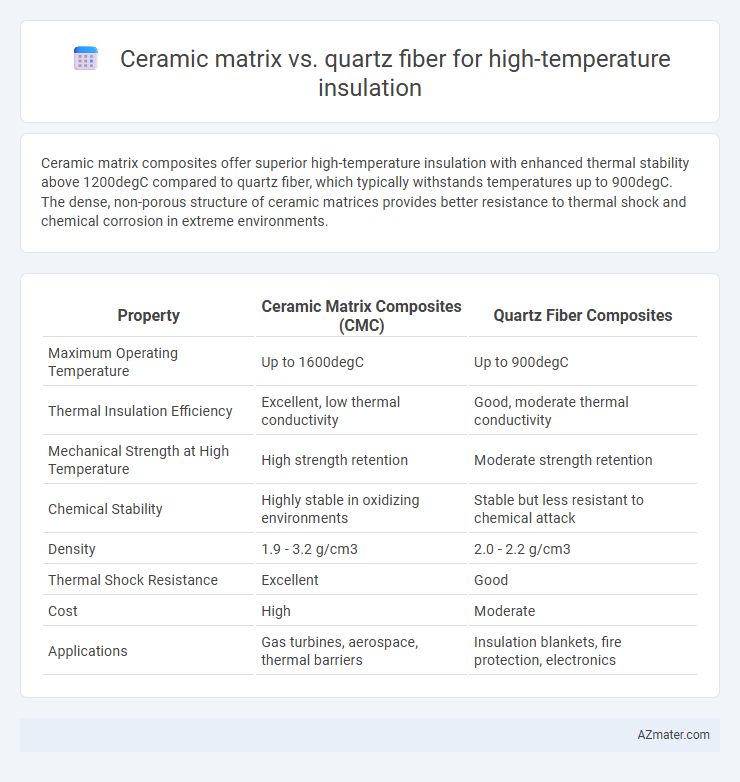Ceramic matrix composites offer superior high-temperature insulation with enhanced thermal stability above 1200degC compared to quartz fiber, which typically withstands temperatures up to 900degC. The dense, non-porous structure of ceramic matrices provides better resistance to thermal shock and chemical corrosion in extreme environments.
Table of Comparison
| Property | Ceramic Matrix Composites (CMC) | Quartz Fiber Composites |
|---|---|---|
| Maximum Operating Temperature | Up to 1600degC | Up to 900degC |
| Thermal Insulation Efficiency | Excellent, low thermal conductivity | Good, moderate thermal conductivity |
| Mechanical Strength at High Temperature | High strength retention | Moderate strength retention |
| Chemical Stability | Highly stable in oxidizing environments | Stable but less resistant to chemical attack |
| Density | 1.9 - 3.2 g/cm3 | 2.0 - 2.2 g/cm3 |
| Thermal Shock Resistance | Excellent | Good |
| Cost | High | Moderate |
| Applications | Gas turbines, aerospace, thermal barriers | Insulation blankets, fire protection, electronics |
Introduction to High Temperature Insulation Materials
High temperature insulation materials like ceramic matrix composites and quartz fiber are engineered for superior thermal resistance in extreme environments. Ceramic matrix composites offer excellent stability and low thermal conductivity at temperatures above 1200degC, making them ideal for aerospace and industrial furnace applications. Quartz fiber insulation provides high tensile strength and thermal shock resistance up to around 1000degC, often used in electrical insulation and high-performance thermal barriers.
Overview of Ceramic Matrix Composites
Ceramic matrix composites (CMCs) offer superior high-temperature insulation by combining ceramic fibers embedded in a ceramic matrix, resulting in enhanced thermal stability and resistance to oxidation compared to quartz fiber materials. CMCs maintain structural integrity at temperatures exceeding 1,200degC, making them ideal for aerospace and industrial applications requiring durable thermal barriers. Their low density and excellent mechanical properties under thermal stress outperform quartz fibers, which typically degrade at elevated temperatures and have lower thermal shock resistance.
Key Properties of Quartz Fiber Insulation
Quartz fiber insulation exhibits exceptional thermal stability withstanding temperatures above 1100degC, making it ideal for high-temperature environments. Its low thermal conductivity and excellent chemical resistance provide superior insulation performance and durability compared to ceramic matrix materials. Quartz fibers also offer high tensile strength and flexibility, ensuring structural integrity under thermal cycling and mechanical stress.
Thermal Stability: Ceramic Matrix vs Quartz Fiber
Ceramic matrices exhibit superior thermal stability compared to quartz fibers, maintaining structural integrity and insulating properties at temperatures exceeding 1200degC, whereas quartz fibers typically degrade above 1000degC. The crystalline structure of ceramic matrices enables resistance to thermal expansion and oxidation, making them ideal for prolonged exposure to high-temperature environments. Quartz fibers, while lightweight and flexible, undergo significant strength reduction and phase transformation under prolonged high-temperature exposure, limiting their application in extreme thermal conditions.
Mechanical Strength Comparison
Ceramic matrix composites exhibit superior mechanical strength at high temperatures compared to quartz fiber, maintaining stability beyond 1200degC due to their robust interfacial bonding and inherent ceramic toughness. Quartz fibers, while effective up to approximately 1000degC, experience tensile strength degradation and reduced creep resistance under prolonged thermal stress. The enhanced fracture toughness and resistance to thermal shock of ceramic matrices make them preferable for high-temperature insulation applications requiring mechanical reliability.
Resistance to Thermal Shock
Ceramic matrix composites exhibit superior resistance to thermal shock compared to quartz fiber insulation due to their inherent ability to withstand rapid temperature fluctuations without cracking. Quartz fiber insulation, while effective at high temperatures, tends to be more brittle and prone to damage under thermal cycling conditions. The enhanced toughness and fracture resistance of ceramic matrix materials make them ideal for applications requiring repeated exposure to drastic temperature changes in aerospace and industrial furnace environments.
Applications in Aerospace and Industry
Ceramic matrix composites (CMCs) offer superior thermal resistance up to 1,500degC, making them ideal for aerospace engine components and industrial gas turbines requiring durable, lightweight insulation. Quartz fibers provide excellent thermal stability up to 1,100degC and are commonly used for electrical insulation and heat shielding in aerospace avionics and industrial high-temperature furnaces. The choice between ceramic matrix and quartz fiber insulation depends on specific temperature thresholds, mechanical strength needs, and environmental exposure in aerospace and industrial applications.
Durability and Lifespan Analysis
Ceramic matrix composites exhibit superior durability and prolonged lifespan under high-temperature insulation conditions compared to quartz fiber, due to their enhanced thermal stability and resistance to oxidation. Quartz fiber insulation tends to degrade faster when exposed to temperatures above 1000degC, leading to reduced mechanical integrity and insulation performance over time. The inherent structural robustness of ceramic matrix materials enables them to maintain insulation properties in extreme thermal environments, making them ideal for long-term applications.
Cost Efficiency and Material Availability
Ceramic matrix composites offer superior high-temperature insulation but come with higher manufacturing costs and limited raw material availability, making them less cost-efficient for large-scale applications. Quartz fiber insulation provides a more economical solution with widespread availability of raw materials and easier processing, though it typically operates effectively at slightly lower temperature ranges. Selecting between the two depends on balancing performance requirements against budget constraints and material supply chain stability.
Choosing the Optimal Insulation Material
Ceramic matrix composites offer superior thermal stability and resistance at temperatures exceeding 1000degC, making them ideal for high-temperature insulation applications in aerospace and industrial furnaces. Quartz fiber insulation provides excellent thermal shock resistance and low thermal conductivity up to around 900degC, suitable for moderate high-temperature environments requiring lightweight materials. Selecting the optimal insulation material depends on operational temperature, mechanical stress tolerance, and thermal conductivity requirements, with ceramic matrices favored for extreme heat and quartz fibers preferred for applications demanding flexibility and lighter weight.

Infographic: Ceramic matrix vs Quartz fiber for High temperature insulation
 azmater.com
azmater.com